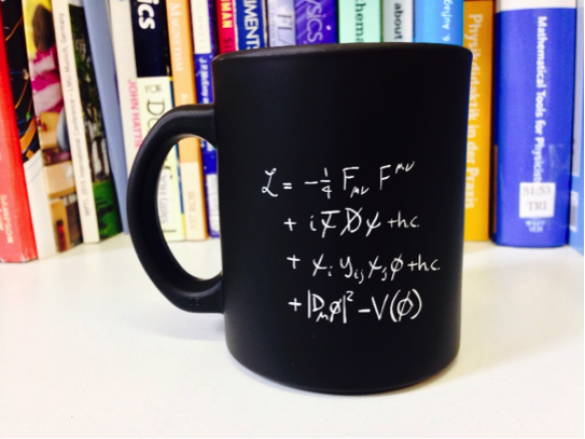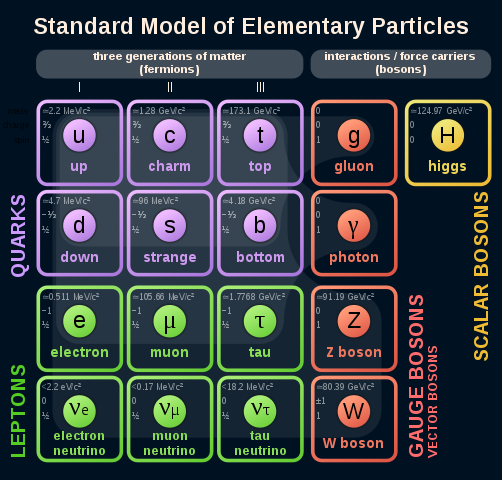
The entire theory of the Standard Model fits on a single mug. Source: CERN.
The Standard Model (SM) of particle physics is a self-consistent theoretical framework which describes three out of the four known fundamental forces of our Universe - the electromagnetic, nuclear strong and nuclear weak force. The SM is a Quantum Field Theory (QFT), in which the fundamental forces are treated mathematically as fields permeating the entirety of space, and in which particles manifest themselves as excitations in these fields.
The SM consists of 12 matter particles, called fermions, and 6 force carrying particles, called bosons. The fermions are split into two groups, quarks and leptons, as well as in three families, or generations. These families are identical to each other in all of their fundamental properties, except for their masses. Virtually everything that we encounter in nature is formed from only the first generation of fermions and the photon, which is the carrier of the electromagnetic interaction. Nearly all visible matter in the Universe is formed of atoms, which in turn is formed from different combinations of protons, neutrons and electrons. The electron is itself a fundamental particle, whereas protons and neutrons are formed by different combinations of the up, u, and the down, d, quarks.
 |
| The elementary particles forming the Standard Model. |
The bosons act as intermediaries of the fundamental forces they are associated with. The Z, W+ and W- carry the weak-force, which rules the process of radioactive decay. The gluon, g, carries the nuclear strong force, which is responsible for the formation of hadrons, such as protons and neutrons. The photon, γ, is the carrier of the electromagnetic interaction, which includes the transmission of the visible light. The final boson, the Higgs, H, is the intermediary of the Higgs field. Through the interaction with this field via the Higgs boson, each fundamental particle of the SM, including the Higgs itself, acquires their only wholly unique property, their mass.
The SM has proven itself to be an almost surprisingly powerful theory. In fact, the SM is the most successful theory not only in physics, but, arguably, in all of science. Some predictions which arise from this theory can be tested experimentally to a precision of one part per trillion. To put this in context, this is the same accuracy as having the uncertainty of the width of a human hair when measuring the distance from the Earth to the Moon.
Despite its success, however, we know that it is an incomplete theory. For example, the SM does not contain a description of the fourth known fundamental force - gravity. In addition to that, the particles and forces contained within the SM describe only the visible, so-called baryonic, matter in the Universe. Yet we know from cosmological observations, that this matter forms only around 5% of the energy content of our Universe, with the rest attributed to the mysterious dark energy and dark matter.
In order to explain gravity, describe the nature of dark matter, understand the origins of dark energy and to answer many other fundamental questions regarding the nature of the Universe we live in, scientists use colossal machines to probe deeper into the properties of the elementary particles that form the world around us and the forces that govern their behaviour. One such machine is the Large Hadron Collider (LHC).